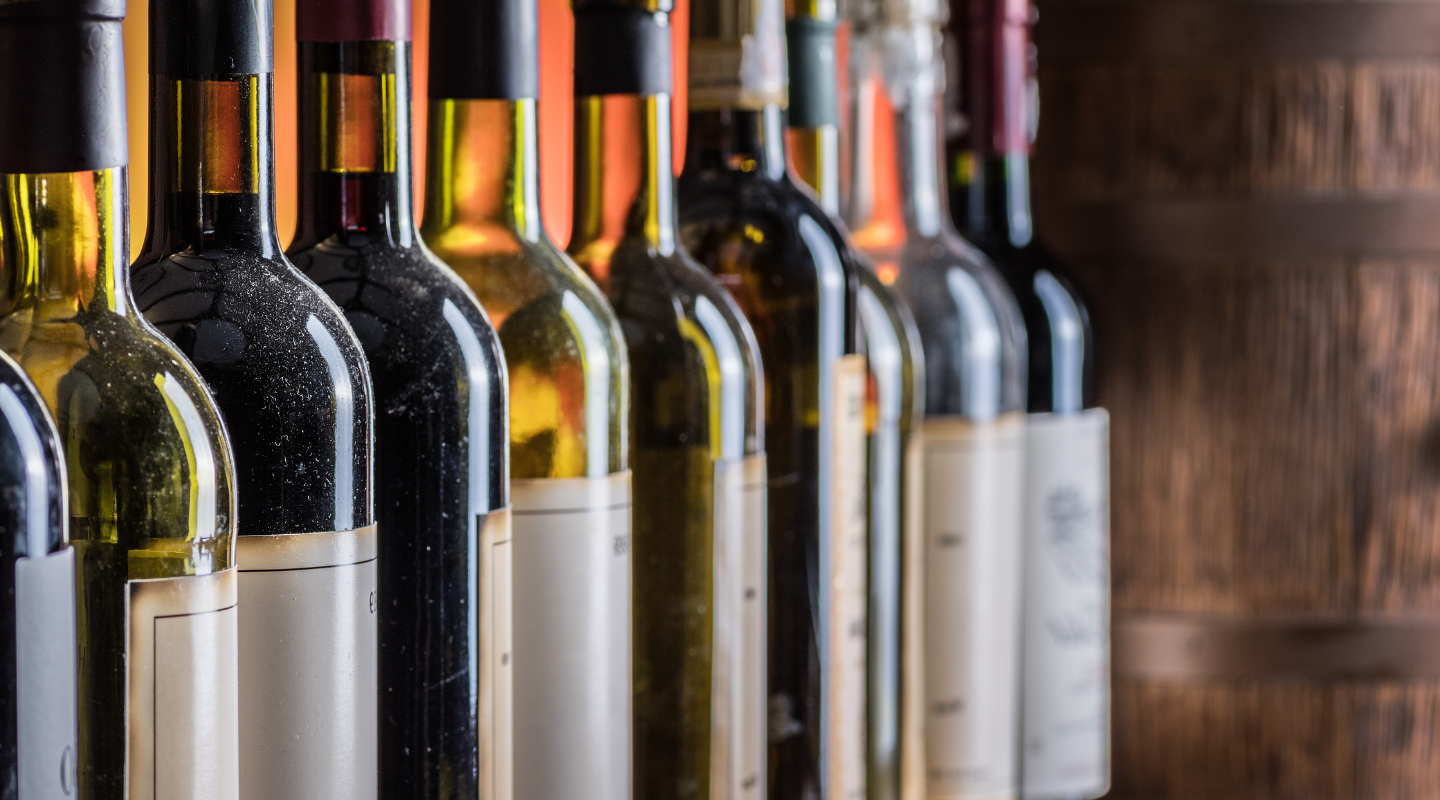The study from Wine Intelligence research aimed to understand consumers’ reasons for buying wine in glass bottles, in an environment increasingly challenged by other packaging formats. Their results were clear. Glass wins on numerous aspects compared to other materials, as it better protects the wine’s quality and taste, adds to the aesthetics and overall drinking experience, and is more sustainable.
When we think of wine, we think of glass. Let us show you why.
History of wine bottles
The history of wine bottles goes all the way back to 4000 B.C. However, we didn’t start using glass for wine bottles until the 17th century. In fact, for a while, people used oak wooden barrels to store their wines.
Still, the wooden barrels had a problem that many packaging materials face: they allowed oxygen to come through the wood and come into contact with the wine inside. While oxygen is used to let wine age, too much oxygen can lead to oxidation. This means the wine starts to break down and actually loses its quality and taste. So, after a wine had aged, it was clear that another material was needed to keep the wine in perfect conditions while it was stored for sale and consumption.
The answer? Glass.
While glass manufacturing has been around for an exceptionally long time, the invention of the coal furnace around 1600 finally made it possible to produce thicker glass and reduce the risk of breakage. Because of this, it was possible for wine to be transported around the world in glass bottles. Although wine was still stored in barrels to be aged, the consumption of wine by individuals shifted to glass bottles.
Glass is engrained in our history and traditions. After hundreds of years, we automatically think of glass when we think of wine. But it also plays an important role in our lives and will continue to do so in our pursuit of a more sustainable future.
Are wine bottles sustainable?
Absolutely! Like any other glass container or jar, wine bottles are made from only three natural resources: sand, soda ash and limestone, along with recycled glass. Obtaining these natural materials doesn’t release any toxic chemicals, nor does it harm our environment.
Even the production of wine bottles has become vastly more sustainable through advanced research and developments in the techniques used to reduce the energy necessary for producing glass bottles.
What’s more, wine is often imported in bulk, specifically with the goal of reducing transport emissions, saving over 90.,000 tonnes of CO2 per year. Of course, if you want to reduce your personal carbon footprint even further, simply choose a bottle from a local producer. In fact, more than 50% of glass bottles are delivered to customers within a 300km distance. The choice is yours!
The glass industry is constantly looking for new ways to address consumers’ wishes for more sustainable products.
Are wine bottles recyclable?
Yes! Wine bottles are 100% and endlessly recyclable. In fact, when you throw a wine bottle in the recycling bin, it only takes 30 days for the bottle to go through the recycling process and end back up on your shelf as a new bottle.
As glass containers are made of a single material, they are easily recyclable without losing any quality. This means that even recycled glass can be recycled again, and again in an endless cycle in which we constantly save C02 emissions, water and resources.
Now that you know why wine bottles are sustainable and recyclable, the question remains: why is glass the preferred choice for wine?
Why Wine Lovers Love Glass
For the best wine experience, the wine itself needs to be produced, stored and consumed properly.
There are four criteria to which the packaging should comply to ensure the best experience when consuming wine:
1. The vessel needs to be strong enough to prevent breakage
2. The material must be sealed to prevent oxidation
3. The vessel should not be too heavy to reduce costs and emissions
4. The material should not interact with the wine itself
So how does glass score on these four criteria?
Strength
Throughout history, glass bottles have come in different shapes, sizes and colours. In the past bottles weren’t as robust as they are today, but the invention of the coal furnace enabled us to produce thicker glass, and thereby stronger glass. This reduced the risk of breakage and allowed us to start storing and transporting wine in glass, instead of clay bottles or large wooden barrels. This opened up new markets for wine producers and merchants, in turn.
Hermetic
Around the same time, people started using wooden barrels for wine storage, and corks for sealing them.
In combination with glass, the wine can be hermetically sealed. No oxygen can enter a glass bottle sealed with a cork, protecting wine from oxidating. Once sealed, bottled wine can last up to a hundred years – although can you really hold off for that long?
Weight
Glass bottles have become considerably lighter in the past 15 years. Light-weighting developments have resulted in producing bottles that can be up to 30% lighter than before. By light-weighting, less material is used, and emissions across the supply chain can be reduced by 10-30%.
With the help of innovative technologies, manufacturers are now able to produce bottles that are thinner, lighter, and stronger than ever before. And these innovations and developments are not going to stop any time soon. Wine bottles will constantly improve to meet the growing demand for more sustainability by consumers.
Inertness
Lastly, glass is also inert, meaning that it doesn’t interact with the wine itself. This is also one of the reasons glass wine bottles are sustainable and easily recyclable. Once the glass has been cleaned, it can be infinitely recycled. Neither ‘new’ glass or recycled glass affects the quality of the wine, nor does it lose any of its own qualities when being recycled.
Glass is the only material that meets all four criteria. It doesn’t alter the taste or quality of the wine and keeps the wine good for a long period of time, so you can open and enjoy it at the right time.
Design and Premium feel
Aside from being a strong, inert, hermetic packaging, wine lovers also enjoy the premium experience that glass bottles provide through their design, elegant feel, and heritage.
The unique design of glass bottles provides a feeling of luxury that other materials can’t match. There is a special feeling when one begins to open a new bottle of wine. A feeling and aesthetic that simply cannot be imitated with any other packaging.
How do wine glass bottles compare to other packaging materials?
As our options increase, people have proposed the use of other packaging options, such as bag-in-box wine or paper wine bottles – which are made from the same materials, but shaped like a bottle. However, these options don’t protect the wine from oxygen, as cardboard itself is not an airtight material. Also, it is unclear how much these materials interact with the wine and alter its taste.
Moreover, bag-in-box wine has a long way to go in improving its sustainability and recyclability. Bag-in-box and paper wine bottles, both suffer from the fact they incorporate materials (metal, aluminium, plastic) that are hard to separate in order to recycle the whole packaging properly. Glass, on the other hand, is easily recycled without any need for separation.
Another option is wine packaged in cans. Yet, while cans are often considered to be a convenient packaging material, researchers found that some canned wines are affected by ‘reductive’ characters, within three to six months of packaging, meaning the wine’s taste is affected and the shelf life is reduced when packaged in cans.
That’s why the majority of wine drinkers in various countries across Europe (Belgium, Netherlands, Sweden, Switzerland, and the UK) agree that glass bottles are a sustainable form of wine packaging compared to other material alternatives.
To taste the wine as it was intended by the producers, glass has been proven to be the best choice throughout time. So how can you ensure that you are storing and serving it as it was intended?
How to safely store wine bottles at home
To ensure the best wine experience for yourself and your guests, we advise you to have a good look at the following five golden rules for safely storing wine bottles at home.
1. Store your wine around 13 degrees Celsius
The best temperature for wine storage is roughly 13 degrees Celsius, but this can vary depending on the wine. Wine should never be kept below –4 degrees Celsius or above 20 degrees Celsius.
2. Store your wine horizontally, not vertically
Storing wine on its side keeps the cork moist, which is important for long-term storage. A dried-out cork can cause leakage and premature aging. While keeping screw top wine bottles on their sides isn’t needed, horizontal storage is still a good idea for maximizing space.
3. Store your wine at a humidity level between 60 and 68%
Higher humidity can damage the bottle’s labels, while lower humidity causes corks to dry up, leaving the wine open to oxidation.
4. Store your wine in a wine fridge
A wine fridge is a good alternative if you don’t have space for a wine cellar. A wine fridge keeps wine at a temperature of 10-15 degrees Celsius and at the right humidity level.
5. Serve your wine at the perfect temperature
Allow time for a stored bottle to reach serving temperature before offering it to other wine lovers. This again depends on the wine. Red wine should be served somewhere between 12 and 19 degrees Celsius. White wines, on the other hand, should be served colder, between 8 and 12 degrees Celsius. This is similar to rosé and sparkling wine, which are both best preserved between 10 and 12 degrees Celsius.
How long can you keep wine after you’ve opened it? This also depends on how you store it! Stored properly, an opened bottle of wine can last 3-5 days.
The best thing to do is to recork it promptly and tightly. If the cork is splintered or has been thrown out, a rubber wine stopper could be a solution to create a tight seal instead.
Why should you choose wine in glass bottles?
For the best wine experience, as it was intended, glass remains the best choice. Glass bottles have a strong association with sustainability and one that is much higher than other packaging materials. Wine, much like glass, is a natural product.
They are not only a mark of quality but will play an important role in a more environmentally friendly future. Due to its unique qualities, glass wine bottles bring a sense of sustainability, luxury and aesthetics and make for a great evening of wine tasting with friends. How do you like to enjoy a glass of your favorite wine? Show us your moments and connect with us on Facebook, Instagram, or Twitter!







